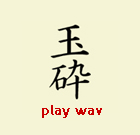

The Shattered Jewel
Originating from a Chinese book dated to the Northern Qi dynasty (6th century C.E.),
Japanese “gyokusai” translates to shattered jewel:
“People of great strength would rather shatter like a jewel into a
myriad of fragments, than to live their life as idle and unbroken as a rooftile.”
Worked into countless legends, novels, poems, mangas, animes, this Eastern motif has a soulmate
in the West: “The light that burns the brightest, burns the shortest.”
And whereever there’s a shattered jewel or a light that burns the brightest,
there’s a story: And stories is what gyokusai is all about.
The Shattered Jewel and the Falling Cherry Blossoms
The Shattered Jewel—like the “Falling Cherry Blossoms” and other
metaphors relating to death and daring, loyalty and
sacrifice—were appropriated by Japan’s crumbling war machinery in the 1940s:
To “retrofit” tradition with legitimizing archetypes for
mass suicides of soldiers and civilians, for the ghastly battle cry
of ichioku gyokusai, the “100 million shattered
jewels.” Telling stories is one approach to reclaiming
these metaphors, to restore them to contexts where they rightfully belong:
to courage and loyalty and the beauty that can lie in
adventure, great deeds, and even death.


